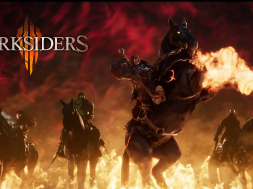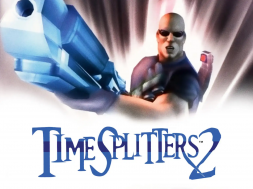
From the constant bombardment of sexist norms and beliefs manifests industrial sexism. By this I refer to sexism demonstrated in the games we play, the business practices of gaming companies, the regulation and maintenance of conventions, the policies of news sites and blogs – the products and services that constitute the industry, essentially. Most of the above operate on traditional values – it’s acceptable to act like a git on the internet because people have been acting the git for ages now; women are paid less than men because, well, that’s the done thing.
While our culture is composed of a fluid network of shared, communicated ideas, the industry sees these ideas come into practice in a myriad forms. When large trends become evident within the industry, such as a slew of straight white male protagonists in a global market, tracing them back to their cultural grounding can grant insight into the conscious and subconscious values weaved throughout the zeitgeist.
Largely speaking, our culture and the industry proper are mutually characterizing. For instance, the vast majority of game protagonists are male because it’s a boy’s club, so they say, and it remains a boy’s club because the selfsame fact relegates female characters/demographics to the sideline. Many female characters become tokenized, adorned with signifiers and traits to characterize them predominantly via their gender, whereas the same treatment is seldom if ever granted of male characters. Choices in game design advance and perpetuate cultural values belonging to the authors.
Similarly, publishers demote women from prominence on box covers because games with women on the cover sell poorly, a truism that prevails so long as publishers continue to refrain from marketing their female characters. Ultimately these habits are founded on harmful (and often deluded) beliefs of what female characters are for or what women enjoy, eventually degrading into stereotyping and gender essentialism. As sexist practices highlight the sexist values which brought them to life, those values are internalized and recur through the similarly-minded behaviours of others.
Books could be compiled on the many glaring examples of sexism in the industry and the ways in which they propagate longstanding values within our broader culture. For the purpose of demonstrating how beliefs characterize industry standards, however, we need only look to the Tomb Raider ‘rape’ fiasco.

Speaking to Kotaku in June of last year, Crystal Dynamics executive producer Ron Rosenberg opted for a rather controversial description of the treatment of Lara Croft in their upcoming game. Rosenberg intimated that, as part of rebooting Lara as a more human and more real character, she is to be beaten, broken, and threatened with rape. Although attempts were made to backtrack on his comments, his meaning was supported by a trailer released that same month.
Unsurprisingly, that such a well-established character would need to be brutalized and sexually assaulted in order to grow into the familiar strong, mature woman proved an unpopular notion among many gaming communities. Some criticized the disparate industry treatment of female and male character development as belittling and insulting. Others derided the use of rape as a narrative device as lazy and exploitative.
Perhaps more telling was how Rosenberg framed his depiction of Lara in terms of player perception. When asked if it was difficult to develop for a female protagonist, Rosenberg remarked that players don’t project themselves into Lara as a character so much as they want to protect her. If true, for all the action-packed blockbuster games out there, this makes Lara Croft something of an oddity – we certainly don’t perceive Batman, Nathan Drake or Solid Snake as removed from the player’s projective capacity. (Note, however, that it’s unclear whether Rosenberg refers to conclusions drawn from surveys and focus groups or if this is his own personal experience.)
The insinuation that players don’t relate to Lara because she is female needs no elaboration – “players”, of course, meaning men. After all, it’s the reason given for why most game protagonists are male. But the assumption that men can’t relate to women is remarkably troublesome when put into real world situations – gender does not serve as a barrier to empathy for anyone but those of the most antiquated worldviews. For an industry bigwig to convey the traditional belief so brashly, however, is quite uncommon, especially attached to such an alienating regard for women as objects to be protected, rather than people to be.
In the context of Lara Croft as a character to whom abuse is directed for the purpose of eliciting protectiveness within the player, the meaning behind the sexual assault scene shifts from something of dubious character development to one as an exercise in player empowerment. In other words, the scene exists in order to make Lara frail and vulnerable and for the player to overcome the assailant and save her. Red flags abound.
 Crystal Dynamics has since invested a lot of energy into closing the wounds opened by Rosenberg. Indeed, the executive may have simply misspoken on behalf of the company, and the final game could prove to be antithetical to his interpretation.
Crystal Dynamics has since invested a lot of energy into closing the wounds opened by Rosenberg. Indeed, the executive may have simply misspoken on behalf of the company, and the final game could prove to be antithetical to his interpretation.
Nevertheless, Rosenberg’s statements represented a grasp of gender roles common to many within the industry – take, for example, John Hemingway referring to a cutesy character designed for unskilled players as “Girlfriend Mode”, or how The Last Guardian was going to have a female protagonist until it was deemed too unrealistic, given the weakness of girls, or the shock expressed by the director of Hitman: Absolution at how a trailer glorifying the sexualisation and subsequent battering could be perceived as offensive.
It’s not so surprising, then, that such negative opinions on fictional women in the medium are internalized and then directed against real women working in the industry.
Late November, under the banner of #1reasonwhy, hundreds if not thousands of women shared personal anecdotes of the various ways in which they had been discriminated against by peers and colleagues on the basis of their gender. Examples ranged from sexual harassment to dismissal of their work and of themselves as entities. Contrary to apologist insistence, each one of these is not itself an anomaly.
When industry practices are understood as expressions of ideas, broader trends can be interpreted as products of widespread cultural values. The feminist dialogue is analysis on both an individual and structural scale. Because of the vast complexity of the relationships between what we say, our meaning and our social context, the truth can be quite elusive, warranting such a lengthy poring over all kinds of cultural artefacts.
Just as this holds for the position of gender within videogames, so too is it applicable to a vast array of subjects such as media portrayals of race and violence, the evolution of game mechanics, the role of the player in fulfilling narrative, the question of videogames as art, and so on. Cultural and personal context governs as much as of what constitutes the industry as it embodies our own individual lives and being.
[words, Stephen Beirne]
From the constant bombardment of sexist norms and beliefs manifests industrial sexism. By this I refer to sexism demonstrated in the games we play, the business practices of gaming companies, the regulation and maintenance of conventions, the policies of news sites and blogs – the products and services that constitute the industry, essentially. Most of the above operate on traditional values – it’s acceptable to act like a git on the internet because people have been acting the git for ages now; women are paid less than men because, well, that’s the done thing.
While our culture is composed of a fluid network of shared, communicated ideas, the industry sees these ideas come into practice in a myriad forms. When large trends become evident within the industry, such as a slew of straight white male protagonists in a global market, tracing them back to their cultural grounding can grant insight into the conscious and subconscious values weaved throughout the zeitgeist.
Largely speaking, our culture and the industry proper are mutually characterizing. For instance, the vast majority of game protagonists are male because it’s a boy’s club, so they say, and it remains a boy’s club because the selfsame fact relegates female characters/demographics to the sideline. Many female characters become tokenized, adorned with signifiers and traits to characterize them predominantly via their gender, whereas the same treatment is seldom if ever granted of male characters. Choices in game design advance and perpetuate cultural values belonging to the authors.
Similarly, publishers demote women from prominence on box covers because games with women on the cover sell poorly, a truism that prevails so long as publishers continue to refrain from marketing their female characters. Ultimately these habits are founded on harmful (and often deluded) beliefs of what female characters are for or what women enjoy, eventually degrading into stereotyping and gender essentialism. As sexist practices highlight the sexist values which brought them to life, those values are internalized and recur through the similarly-minded behaviours of others.
Books could be compiled on the many glaring examples of sexism in the industry and the ways in which they propagate longstanding values within our broader culture. For the purpose of demonstrating how beliefs characterize industry standards, however, we need only look to the Tomb Raider ‘rape’ fiasco.

Speaking to Kotaku in June of last year, Crystal Dynamics executive producer Ron Rosenberg opted for a rather controversial description of the treatment of Lara Croft in their upcoming game. Rosenberg intimated that, as part of rebooting Lara as a more human and more real character, she is to be beaten, broken, and threatened with rape. Although attempts were made to backtrack on his comments, his meaning was supported by a trailer released that same month.
Unsurprisingly, that such a well-established character would need to be brutalized and sexually assaulted in order to grow into the familiar strong, mature woman proved an unpopular notion among many gaming communities. Some criticized the disparate industry treatment of female and male character development as belittling and insulting. Others derided the use of rape as a narrative device as lazy and exploitative.
Perhaps more telling was how Rosenberg framed his depiction of Lara in terms of player perception. When asked if it was difficult to develop for a female protagonist, Rosenberg remarked that players don’t project themselves into Lara as a character so much as they want to protect her. If true, for all the action-packed blockbuster games out there, this makes Lara Croft something of an oddity – we certainly don’t perceive Batman, Nathan Drake or Solid Snake as removed from the player’s projective capacity. (Note, however, that it’s unclear whether Rosenberg refers to conclusions drawn from surveys and focus groups or if this is his own personal experience.)
The insinuation that players don’t relate to Lara because she is female needs no elaboration – “players”, of course, meaning men. After all, it’s the reason given for why most game protagonists are male. But the assumption that men can’t relate to women is remarkably troublesome when put into real world situations – gender does not serve as a barrier to empathy for anyone but those of the most antiquated worldviews. For an industry bigwig to convey the traditional belief so brashly, however, is quite uncommon, especially attached to such an alienating regard for women as objects to be protected, rather than people to be.
In the context of Lara Croft as a character to whom abuse is directed for the purpose of eliciting protectiveness within the player, the meaning behind the sexual assault scene shifts from something of dubious character development to one as an exercise in player empowerment. In other words, the scene exists in order to make Lara frail and vulnerable and for the player to overcome the assailant and save her. Red flags abound.
 Crystal Dynamics has since invested a lot of energy into closing the wounds opened by Rosenberg. Indeed, the executive may have simply misspoken on behalf of the company, and the final game could prove to be antithetical to his interpretation.
Crystal Dynamics has since invested a lot of energy into closing the wounds opened by Rosenberg. Indeed, the executive may have simply misspoken on behalf of the company, and the final game could prove to be antithetical to his interpretation.
Nevertheless, Rosenberg’s statements represented a grasp of gender roles common to many within the industry – take, for example, John Hemingway referring to a cutesy character designed for unskilled players as “Girlfriend Mode”, or how The Last Guardian was going to have a female protagonist until it was deemed too unrealistic, given the weakness of girls, or the shock expressed by the director of Hitman: Absolution at how a trailer glorifying the sexualisation and subsequent battering could be perceived as offensive.
It’s not so surprising, then, that such negative opinions on fictional women in the medium are internalized and then directed against real women working in the industry.
Late November, under the banner of #1reasonwhy, hundreds if not thousands of women shared personal anecdotes of the various ways in which they had been discriminated against by peers and colleagues on the basis of their gender. Examples ranged from sexual harassment to dismissal of their work and of themselves as entities. Contrary to apologist insistence, each one of these is not itself an anomaly.
When industry practices are understood as expressions of ideas, broader trends can be interpreted as products of widespread cultural values. The feminist dialogue is analysis on both an individual and structural scale. Because of the vast complexity of the relationships between what we say, our meaning and our social context, the truth can be quite elusive, warranting such a lengthy poring over all kinds of cultural artefacts.
Just as this holds for the position of gender within videogames, so too is it applicable to a vast array of subjects such as media portrayals of race and violence, the evolution of game mechanics, the role of the player in fulfilling narrative, the question of videogames as art, and so on. Cultural and personal context governs as much as of what constitutes the industry as it embodies our own individual lives and being.
[words, Stephen Beirne]










